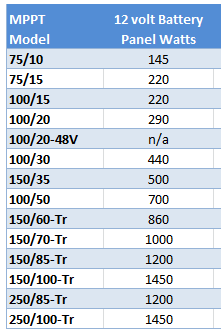Solar System for a Catamaran
When planning a solar installation on a catamaran you first need to consider shading. If all the panels are shaded equally then you can group them together with a single charge controller. If however you end up with panels that are Port, Starboard and Aft and would have three different shading characteristics then you would end up with three charge controllers.
Next you need to see how many watts of solar you will have per charge controller by referring to the table below. This table is for a 12 volt battery system.

Finally you need to decide if you will put the panels in series or parallel, and what the open circuit voltage will be when you do that.
Putting panels in series raises the voltage and gives the charge controller more to work with. It also means that you can have smaller wires between the panels and the controller because with the higher voltage the current will be less. Panels in series (when blocking diodes are fitted) are more tolerant of partial shade. So there are some advantages to putting the panels in series to get a higher voltage. However there are limits to how high you can afford to let the voltage go.
The first limit is that of the charge controller. In the table above the first number of the charge controller at the top of the list (75/15) refers to the maximum allowed voltage. For this example 75 volts is the maximum open circuit voltage allowed. Victron ask you to please keep it 10% less than the max if possible.
The second limit is to do with how electricity and water don't mix. If you get the voltage too high you could get an electric shock and so for that reason you might want to keep it no more than around 50 volts. There are no standards for this at the moment so you just have to use common sense. When using higher voltages its always a good idea to get the Wirebox terminal covers for the MPPT's to ensure nobody gets a shock.
Related Articles
Calculating wire size in a solar system
The current flowing in the wires of a solar system depends on the power that is being transferred. The relevant formula is Watts = Volts x Amps. When calculating wiring sizes there are two separate circuits operating at different voltages and so ...Solar panel size for powerboat
This is the table showing what charge controller goes with what panels. It depends on your system voltage, for example if you have a 12 volt boat the 100/50 can accommodate 700 watts of panels but if you have a 24 volt boat the same controller can ...MPPT troubleshooting section in the instruction manual
The links below go directly to the troubleshooting section of the relevant instruction manual: Smart Solar MPPT 75/10 up to 100/20 Smart Solar 100/30 and 100/50 Smart Solar 150/35 and 150/45 Smart Solar 150/60 and up Smart Solar 150/70 VE Can and up ...Index to technical writing
Our Technical Pages has an index to the technical articles on our website. This index includes all our blog posts. In addition our Blog is divided up into sections as follows: Alternators System Integration Battery Chargers Battery Combiners ...Troubleshooting MultiPlus
Here are some generic tips for troubleshooting a MultiPlus 1. To reboot the processor disconnect the AC and DC connections and leave them both off at the same time for at least 30 seconds 2. With AC and DC power disconnected check for loose ...